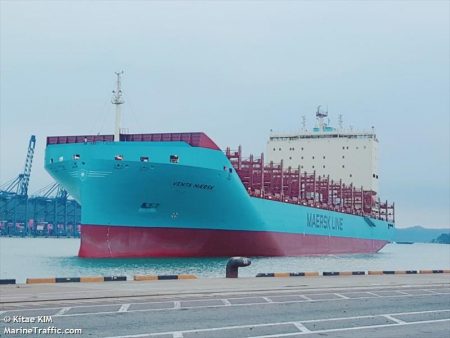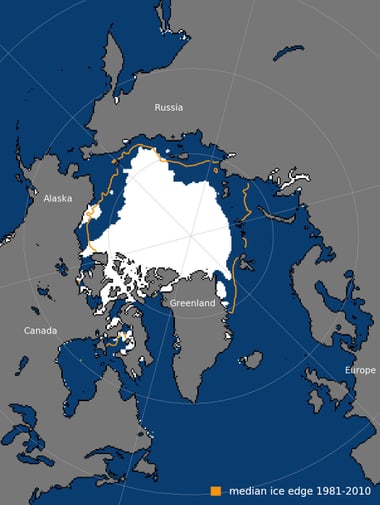August 22, 2018 – The world’s largest container shipping company, Maersk, is about to send its latest “boxship” on a northern sea route from Vladivostok, Russia, through the Bering Strait and then east across the Arctic Ocean to its destination in Bremerhaven, Germany. The ship, Venta Maersk, is one of seven vessels that the container shipping company intends to use should this voyage prove that trans-Arctic sea routes make sense for the company over the longer term.

Both Russia and China have been testing Arctic Ocean shipping for the last few years, sending a few ice-reinforced natural gas, and oil tankers across Russia’s northern coast to determine the long-term viability of the route. A spokesperson for Maersk is quoted in Splash yesterday stating, “This is a one off….It is important to underline that this is a trial designed to explore an unknown route for container shipping and to collect scientific data.”
Maersk still sees the Suez Canal as the usual route in sending ships from Asian ports to Europe. The northern route across the Arctic Ocean right now is viable for three months each year. Vessels traveling must be ice class which means they are equipped with ice-breaking technology and reinforced hulls.
On this voyage, Venta Maersk is carrying a cargo of frozen fish. The ship is designed to operate in cold waters down to temperatures of -25 Celsius (-13 Fahrenheit). Gross tonnage is just under 35,000. You can follow the ship’s progress on the Venta Maersk Marine Traffic site throughout its voyage.
So why is it possible now to send large tonnage cargo ships through the Arctic Ocean?
Just in case you haven’t caught up with the latest Arctic Ocean ice news, it appears that some of the oldest “permanent” sea ice is no longer permanent. Open water is appearing in places where scientists studying the Arctic have never seen it before. Sea ice between 4 and 20 meters (13 to 65 feet) thick has been affected by abnormally warm temperatures in February and March of this year. Open water is now appearing north of Greenland.
A temporary phenomenon for sure, caused by a combination of warmer temperatures and winds, this Greenland sea ice anomaly will probably vanish soon. But while it remains open solar energy will heat the water column just enough to thin the ice for the next season, delaying the freeze up just a bit more than before. If the trend continues it likely means the ocean at the top of Greenland may become ice-free for longer periods in subsequent years. Each day of open water adds more heat to the Arctic Ocean in a reinforcing feedback effect.
How viable will shipping be across the Arctic Ocean in the next decade?
Take a look at the map image below. It shows Arctic sea ice extent for August 15, 2018. The area marked in white is the extent of sea ice coverage, some 5.7 million square kilometers (2.2 million square miles). The orange lines drawn on the map show the average extent of sea ice on the same date based on data records from 1981 to 2010. The map clearly shows just how much of the Arctic Ocean has become ice free in less than forty years.

Melting Arctic sea ice has other implications besides opening sea routes to Maersk container ships. The flood of cold meltwater is impacting the flow of the Gulf Stream and North Atlantic Drift which warms Europe. From Northern Scandinavia to Siberia this summer has seen record temperatures above 30 Celsius (86 Fahrenheit) and dry conditions in areas above the Arctic Circle. Forest fires have broken out in Sweden’s north as well as in Siberia, places that have not seen this happen since the beginning of historical record keeping.
Climatologists are more than concerned by what the data trends show. Current rates of Arctic Ocean sea ice seasonal shrinkage point to an ice-free summer at the North Pole by 2050. You can guess the implications for ocean sea level rise if this scenario holds true.















